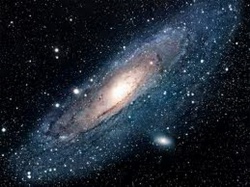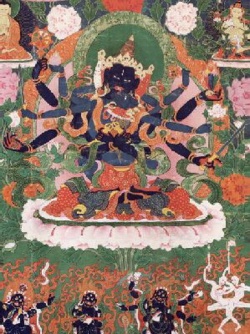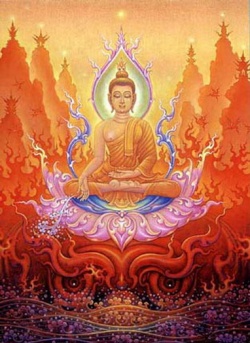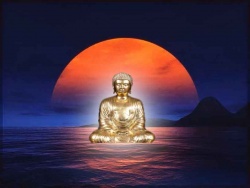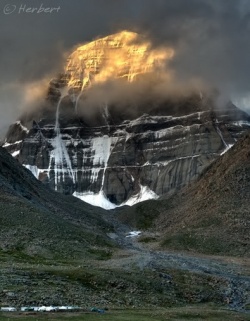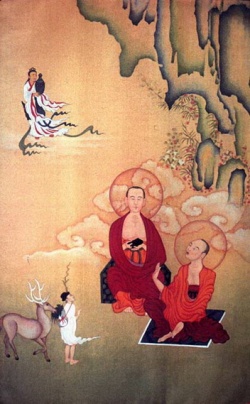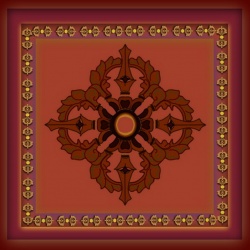Kalpa
Kalpa (Skt.; Tib. བསྐལ་པ་, Wyl. bskal pa) — an aeon, a vast period of time related to the different phases of a great universe (or trichiliocosm), according to Abhidharma literature.
A great kalpa (Skt. mahākalpa; Tib. བསྐལ་ཆེན་, Wyl. bskal chen) is the period of time during which the universe passes through the four periods (or medium kalpas) of
- formation (Tib. ཆགས་པའི་བསྐལ་པ་, Wyl. chags pa'i bskal pa),
- duration (Tib. གནས་པའི་བསྐལ་པ་, Wyl. gnas pa'i bskal pa),
- destruction (Tib. འཇིག་པའི་བསྐལ་པ་, Wyl. 'jig pa'i bskal pa) and
- voidness (Tib. སྟོང་པའི་བསྐལ་པ་, Wyl. stong pa'i bskal pa).
Each of these four periods is made up of twenty intermediate kalpas, which are also sometimes subdivided into periods of increase and decrease (of the merit and life-span of beings living during that period).
Further Reading
- Kangyur Rinpoche, Treasury of Precious Qualities (Boston & London: Shambhala, 2001), 'Appendix I'.
- Patrul Rinpoche, The Words of My Perfect Teacher (Boston: Shambhala, Revised edition, 1998), pages 25-26.
Source
Kalpa is a Sanskrit word (कल्प kalpa) meaning an aeon, or a relatively long period of time (by human calculation) in Hindu and Buddhist cosmology. The concept is first mentioned in the Mahabharata.
The definition of a kalpa equalling 4.32 billion years is found in the Puranas (specifically Vishnu Purana and Bhagavata purana).
Buddhism
According to Visuddhimagga, there are several explanations for types of Kalpas and their duration. In the first explanation, there are four types:
- Ayu-Kalpa - a variable time span representing the Life expectancy of a typical human being in a particular era or Yuga. This can be as high as one Asankya or as small as 10 years. This number is directly proportional to the level of Virtue of people in that era. Currently this value hovers around 100 years and is continually decreasing.
- Antah-Kalpa - time taken for one Ayu-Kalpa to grow from 10 years up to one Asankya and back to 10 years. Ending of one Antah-Kalpa (or mass-extinction) can happen in three ways where majority of the human population gets extinct:
- Sashthrantha-Kalpa - Mass extinction by wars.
- Durbhikshantha-Kalpa - Mass extinction by hunger.
- Rogantha-Kalpa - Mass extinction by plague.
- Asankya-Kalpa - time span of 20 Antah-Kalpas. One is equivalent to a quarter of Maha-Kalpa.
- Maha-Kalpa - largest time unit in Buddhism. Ending of a Maha-Kalpa (apocalypse) can happen in three ways: Fire, water and wind. It is divided into four quarters each equivalent to one Asankya-Kalpa.
In another simple explanation, there are four different lengths of Kalpas. A regular kalpa is approximately 16 million years long (16,798,000 years ), and a small kalpa is 1000 regular Kalpas, or about 16 billion years. Further, a medium kalpa is roughly 320 billion years, the equivalent of 20 small Kalpas. A great kalpa is 4 medium Kalpas, or around 1.28 trillion years.
Buddha had not spoken about the exact length of the Maha-kalpa in number of years. However, he had given several astounding analogies to understand it.
1. Imagine a huge empty cube at the beginning of a kalpa, approximately 16 miles in each side. Once every 100 years, you insert a tiny mustard seed into the cube. According to The Buddha, the huge cube will be filled even before the kalpa ends.
2. Imagine a gigantic rocky mountain at the beginning of kalpa, approximately 16 x 16 x 16 miles (dwarfing Mt. Everest).
You take a small piece of silk and wipe the mountain once every 100 years. According to The Buddha, the mountain will be completely depleted even before the kalpa ends.
In one situation, some Monks wanted to know how many Kalpas had died so far. The Buddha gave the analogy:
1. If you count the total number of sand particles at the depths of the Ganges river, from where it begins to where it ends at the sea, even that number will be less than the number of passed Kalpas.
Hinduism
In Hinduism (cf. Hindu Time Cycles), it is equal to 4.32 billion yea
rs, a "day of Brahma" or one thousand mahayugas, measuring the duration of the World (scientists estimate the age of the Earth at 4.54 billion years). Each kalpa is divided into 14 manvantara periods, each lasting 71 Yuga cycles (306,720,000 years).
Preceding the first and following each manvatara period is a juncture (sandhya) the length of a Satya-Yuga (1,728,000) years.
Two Kalpas constitute a day and night of Brahma.
A "month of Brahma" is supposed to contain thirty such days (including nights), or 259.2 billion years.
According to the Mahabharata, 12 months of Brahma (=360 days) constitute his year, and 100 such years the Life cycle of The Universe.
Fifty years of Brahma are supposed to have elapsed, and we are now in the shvetavaraha-kalpa of the fifty-first; at the end of a Kalpa the World is annihilated.
Kalpa and other periods of time
"The duration of the material Universe is limited.
It is manifested in cycles of Kalpas.
A kalpa is a day of Brahmā, and one day of Brahmā consists of a thousand cycles of four yugas, or ages:
Satya, Tretā, Dvāpara and Kali.
The cycle of Satya is characterized by Virtue, Wisdom and Religion, there being practically no Ignorance and vice, and the Yuga lasts 1,728,000 years.
In the Tretā-Yuga vice is introduced, and this Yuga lasts 1,296,000 years.
In the Dvāpara-Yuga there is an even greater decline in Virtue and Religion, vice increasing, and this Yuga lasts 864,000 years.
And finally in Kali-Yuga (the Yuga we have now been experiencing over the past 5,000 years) there is an abundance of strife, Ignorance, irreligion and vice, true Virtue being practically nonexistent, and this Yuga lasts 432,000 years.
In Kali-Yuga vice increases to such a point that at the termination of the Yuga the Supreme Lord Himself appears as the Kalki avatāra, vanquishes the demons, saves His devotees, and commences another Satya-Yuga.
Then the process is set rolling again.
These four yugas, rotating a thousand times, comprise one day of Brahmā, and the same number comprise one night. Brahmā lives one hundred of such "years" and then dies.
These "hundred years" total 311 trillion 40 billion (311,040,000,000,000) Earth years.
By these calculations the Life of Brahmā seems fantastic and interminable, but from the viewpoint of eternity it is as brief as a lightning flash.
In the Causal Ocean there are innumerable Brahmās rising and disappearing like bubbles in the Atlantic.
Brahmā and his creation are all part of the material Universe, and therefore they are in Constant flux."([[Bhagavad-gītā As It Is 8.17)
Names of the Kalpas
The names of 30 Kalpas are found in the Matsya Purana (290.3-12).
These are:
- Śveta
- Nīlalohita
- Vāmadeva
- Rathantara
- Raurava
- Deva
- Vṛhat
- Kandarpa
- Sadya
- Iśāna
- Tamah
- Sārasvata
- Udāna
- Gāruda
- Kaurma
- Nārasiṁha
- Samāna
- Āgneya
- Soma
- Mānava
- Tatpumān
- Vaikuṇṭha
- Lakṣmī
- Sāvitrī
- Aghora
- Varāha
- Vairaja
- Gaurī
- Māheśvara and
- Pitṛ
The Vayu Purana in chapter 21 gives a different list of 28 Kalpas.
It also lists five more Kalpas in the next chapter.
Brahma Kumaris
According to the teaching of Brahma Kumaris World Spiritual University, an India-based doomsday cult, the Kalpa is much shorter – only of 5,000 years and five with ages, Golden, Silver, Copper, Iron and Diamond Age or Confluence Age ([[Sangum[Yuga]]).
We are currently at the end of darkest Iron Age (Kali Yuga) and soon the cycle will come to an end followed by Destruction.
Source
In ancient Indian cosmology, an extremely long period of time.
There are various views on the length of a kalpa.
According to The Treatise on the Great Perfection of Wisdom, a kalpa is longer than the time required to wear away a cube of rock forty ri (one ri being about 450 meters) on each side, by brushing it with a piece of cloth once every hundred years.
Great Perfection of Wisdom also defines a kalpa as being longer than the time needed to remove all the mustard seeds filling a city forty ri square, if one takes away one seed every hundred years.
Nearly identical explanations appear in the Miscellaneous Agama Sutra, where the length of each side of the rock is given as one yojana (about 7 kilometers), and the size of the city as one yojana square.
The word kalpa is also used in describing the formation and disintegration of the world.
According to Buddhist cosmology, a world perpetually repeats a four-stage cycle of formation, continuance, decline, and disintegration.
The periods corresponding to these four stages are called the four kalpas.
Each of these four kalpas —the kalpa of formation, the kalpa of continuance, the kalpa of decline, and the kalpa of disintegration—lasts for twenty small kalpas.
A small kalpa is defined in terms of cyclical changes said to occur repeatedly in the human life span during the kalpa of continuance.
Over the course of a small kalpa, the human life span increases from 10 to 80,000 years and then decreases from 80,000 to 10 years.
The increase of life span occurs at the rate of one year every hundred years, and the decrease of life span also occurs in the same way.
During the kalpa of continuance, a world and its inhabitants continue to exist for twenty small kalpas, that is, while the human life span repeats its increase and decrease in this way.
The time required for the life span to increase from 10 to 80,000 years is 79,990 years multiplied by 100, which equals 7,999,000 years.
Exactly the same number of years is necessary for the decrease in life span from 80,000 to 10 years; that is, 7,999,000 is multiplied by two, equaling 15,998,000 years. Thus, this number represents the length of a small kalpa.
Because a small kalpa is often described simply as a kalpa, 15,998,000 years, or about 16,000,000 years, is often given as the definition of the length of a kalpa.
Source
Periodic manifestations and dissolutions of universes which go on etemally.
Great kalpas consist of four asamkhiya kalpas corresponding to childhood. maturity, old age and the death of the universe.
Kalpa in Sanskrit, Kappa in Pali.
It is a fabulous period of four hundred and thirty two million years of mortals, measuring the duration of world. It is the period of time between other creation and recreation of a world or universe.
existence,
destruction and
emptiness
as a complete period, is called maha kalpa or great kalpas.
Each great kalpa is subdivided into four asamkhyeya-kalpas or kalpas.
Each of the four kalpas is subdivided into twenty antara-kalpas, or small kalpas.
There are different distinctions and illustrations of kalpas.
In general, a small kalpa is represented as 16,800,000 years, a kalpa as 336,000,000 years and a mahakalpa is 1,334,000,000 years.
Source
Kalpa: A kalpa is roughly equivalent to the English eon, and it similarly used in Indian thought, representing geologic spans of time. There are numerous reckonings of just how long of a period a kalpa represents. A special type of kalpa is the asaïkhya kalpa, four of which delimit the lifetime of a world in Buddhist cosmology. These four kalpas are period of creation, development, decay, and destruction of the world respectively.
